[Day-1] Introduction to DevOps
 Ranjan Yadav
Ranjan YadavHi Everyone, today is day-1 and I am going to start from scratch how the DevOps fit into the software development life cycle. Below is the pictures which outlines the different IT roles involved in the software development and delivery process, broken down into three primary categories: Software Development, Software Testing, and Operations. Here's a detailed overview of each category along with the various cycles in the software development process:
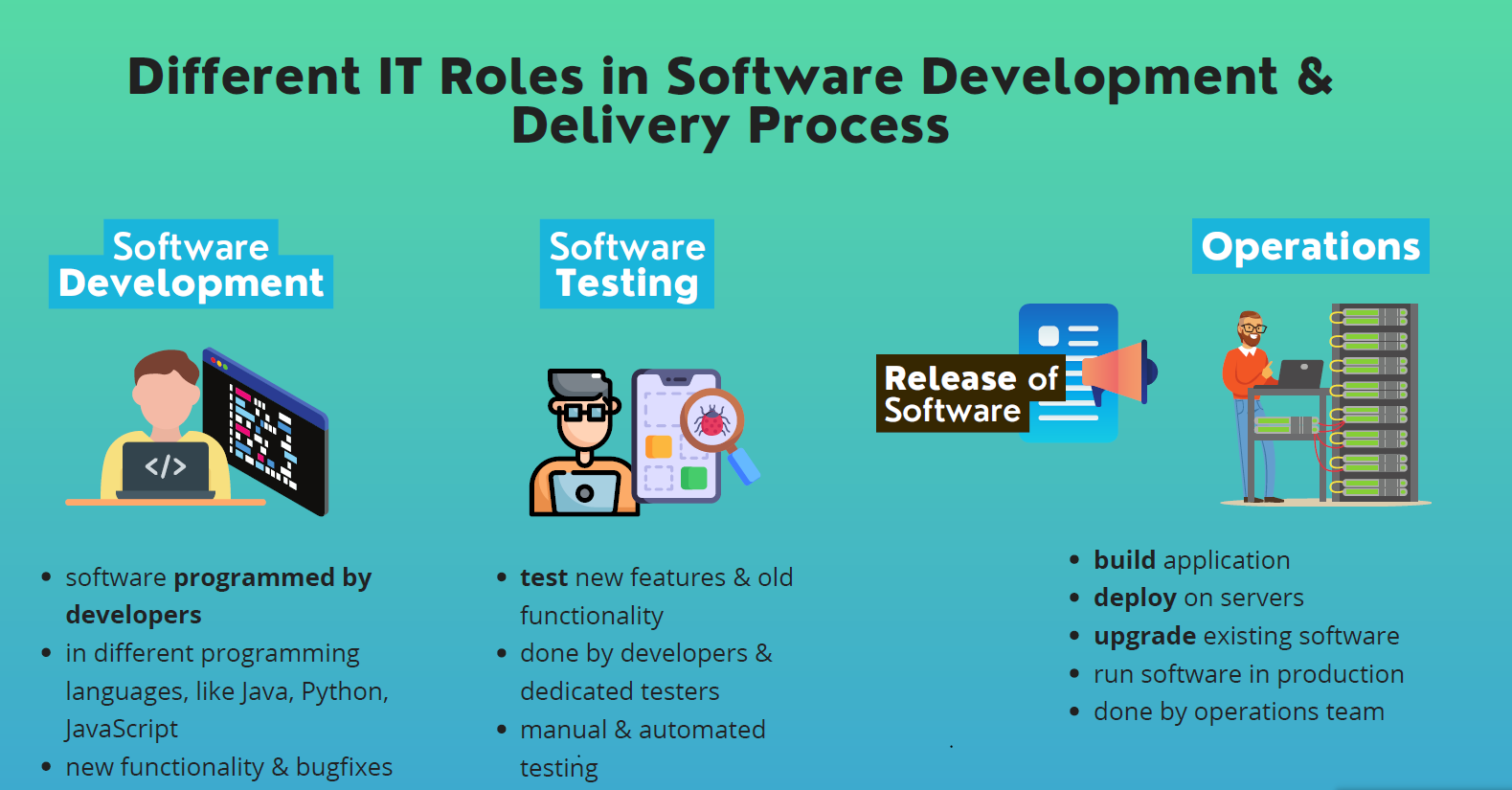
1. Software Development
Activities:
Programming: Developers write code using various programming languages such as Java, Python, JavaScript, etc.
Functionality & Bugfixes: Developers implement new functionalities and fix bugs within the software.
Cycle:
Requirement Analysis: Understand and document what the users need.
Design: Plan the architecture and design of the software.
Implementation (Coding): Write the actual code based on the design.
Unit Testing: Test individual units of code to ensure they work correctly.
2. Software Testing
Activities:
Testing New Features & Old Functionality: Ensure that both new and existing features work as expected.
Done by Developers & Dedicated Testers: Can be performed by the original developers or specialized QA testers.
Manual & Automated Testing: Use of manual testing and automated testing tools to verify software functionality.
Cycle:
Test Planning: Determine the scope, approach, resources, and schedule of the testing activities.
Test Design: Create test cases, test scripts, and prepare test data.
Test Execution: Run the tests manually or using automated tools.
Defect Reporting: Identify, document, and report defects or bugs found during testing.
Retesting & Regression Testing: Retest the fixed issues and ensure new code changes haven’t introduced new defects.
3. Operations
Activities:
Build Application: Compile the code and create executable software.
Deploy on Servers: Install the software on production servers.
Upgrade Existing Software: Apply updates and upgrades to the software.
Run Software in Production: Monitor and maintain the software to ensure it runs smoothly in a live environment.
Done by Operations Team: These tasks are typically handled by system administrators, DevOps engineers, or operations staff.
Cycle:
Release Management: Plan and manage the release of new software versions.
Deployment: Deploy the software to production environments.
Monitoring & Incident Management: Monitor the software for issues and manage incidents as they arise.
Maintenance & Support: Provide ongoing support and maintenance, including applying patches and updates.
Backup & Recovery: Ensure data is backed up and can be recovered in case of failures.
Integrated Development & Delivery Cycle
Planning: Gather requirements, plan the project, and allocate resources.
Development: Write and compile code to create the software.
Testing: Verify that the software works as intended and is free of bugs.
Release: Prepare and deploy the software to the production environment.
Monitoring: Continuously monitor the software to detect and address issues promptly.
Maintenance: Regularly update and improve the software to meet evolving user needs.
This detailed overview emphasizes the collaborative nature of software development, involving multiple roles and cycles to ensure the delivery of high-quality software products. Each phase is crucial and contributes to the overall success of the software development lifecycle (SDLC).
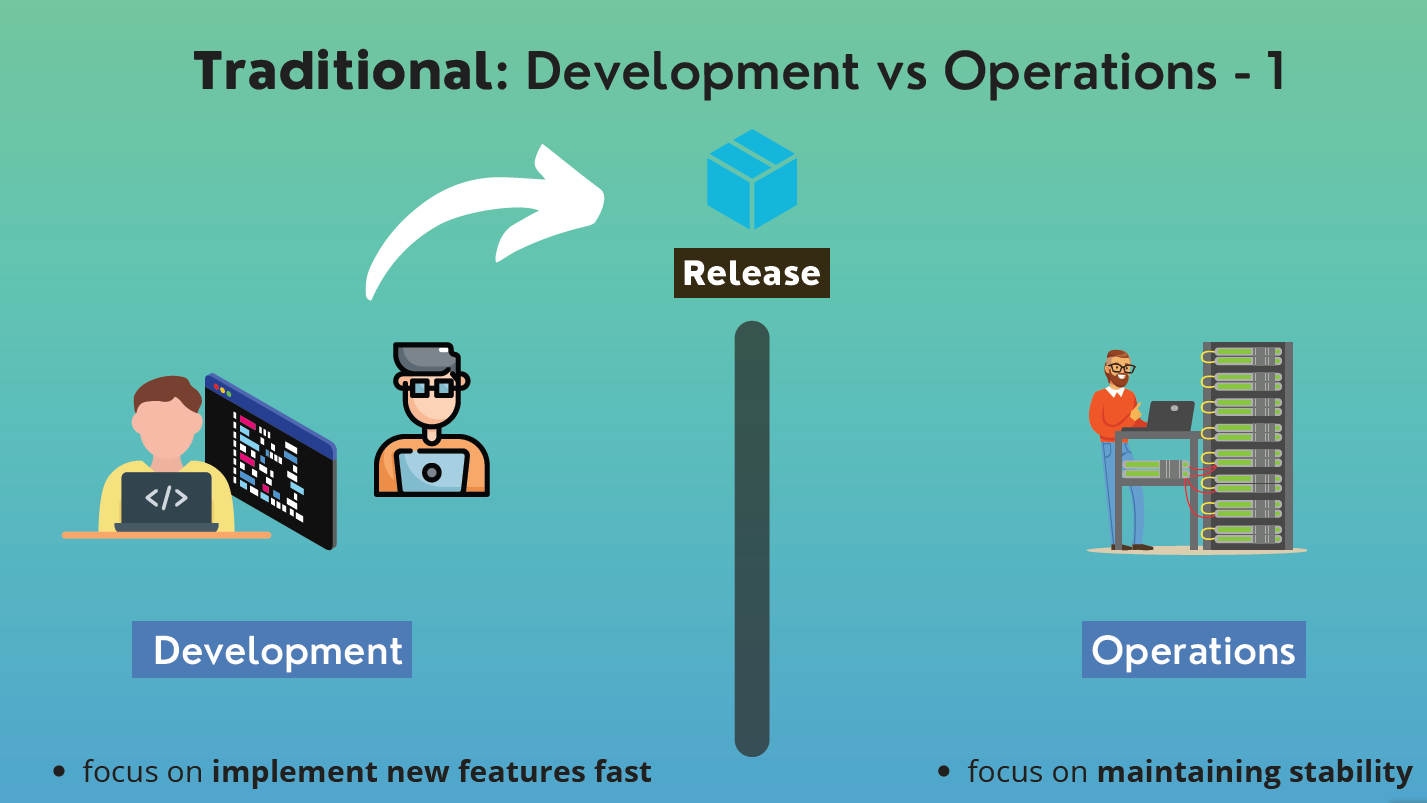
The above image provided illustrates the traditional distinction between development and operations in the software lifecycle. Here's a detailed overview of this traditional model:
Traditional: Development vs. Operations
Development:
Focus: Implement new features quickly.
Activities:
Writing and modifying code.
Adding new functionalities.
Fixing bugs.
Collaborating on design and architecture.
Goal: Deliver new features and improvements to the software as rapidly as possible.
Operations:
Focus: Maintaining stability.
Activities:
Deploying applications to production environments.
Monitoring system performance.
Managing infrastructure.
Ensuring reliability and uptime.
Goal: Keep the software running smoothly in the production environment without interruptions or downtime.
Traditional Model Workflow
Development Phase:
Developers focus on building and enhancing the software.
Rapid development cycles aim to implement new features quickly.
Release:
The completed code is packaged and handed over to the operations team.
This handoff marks the transition from development to production.
Operations Phase:
The operations team deploys the software to live servers.
They monitor the software’s performance and manage any issues that arise.
Their primary goal is to maintain system stability and reliability.
Challenges in the Traditional Model
Siloed Teams:
Development and operations teams often work in isolation from each other.
Lack of communication can lead to misunderstandings and inefficiencies.
Delayed Feedback:
Operations issues might not be communicated back to developers promptly.
Developers may not be aware of real-world performance and reliability issues.
Conflict of Interests:
Developers aim for rapid feature deployment, while operations prioritize system stability.
This conflicting focus can lead to friction and suboptimal outcomes.
Slow Releases:
The handoff process between development and operations can introduce delays.
Manual deployment processes can be time-consuming and error-prone.
Evolution to DevOps
To address these challenges, many organizations are shifting to a DevOps model, which integrates development and operations practices. DevOps emphasizes:
Collaboration: Enhanced communication and cooperation between development and operations teams.
Automation: Use of automated tools for testing, deployment, and monitoring to speed up the release process.
Continuous Integration and Continuous Deployment (CI/CD): Frequent, automated releases that integrate changes continuously.
Shared Responsibility: Both teams share the responsibility for the software’s performance and reliability.
This integrated approach aims to deliver high-quality software quickly while maintaining stability and reliability in the production environment.
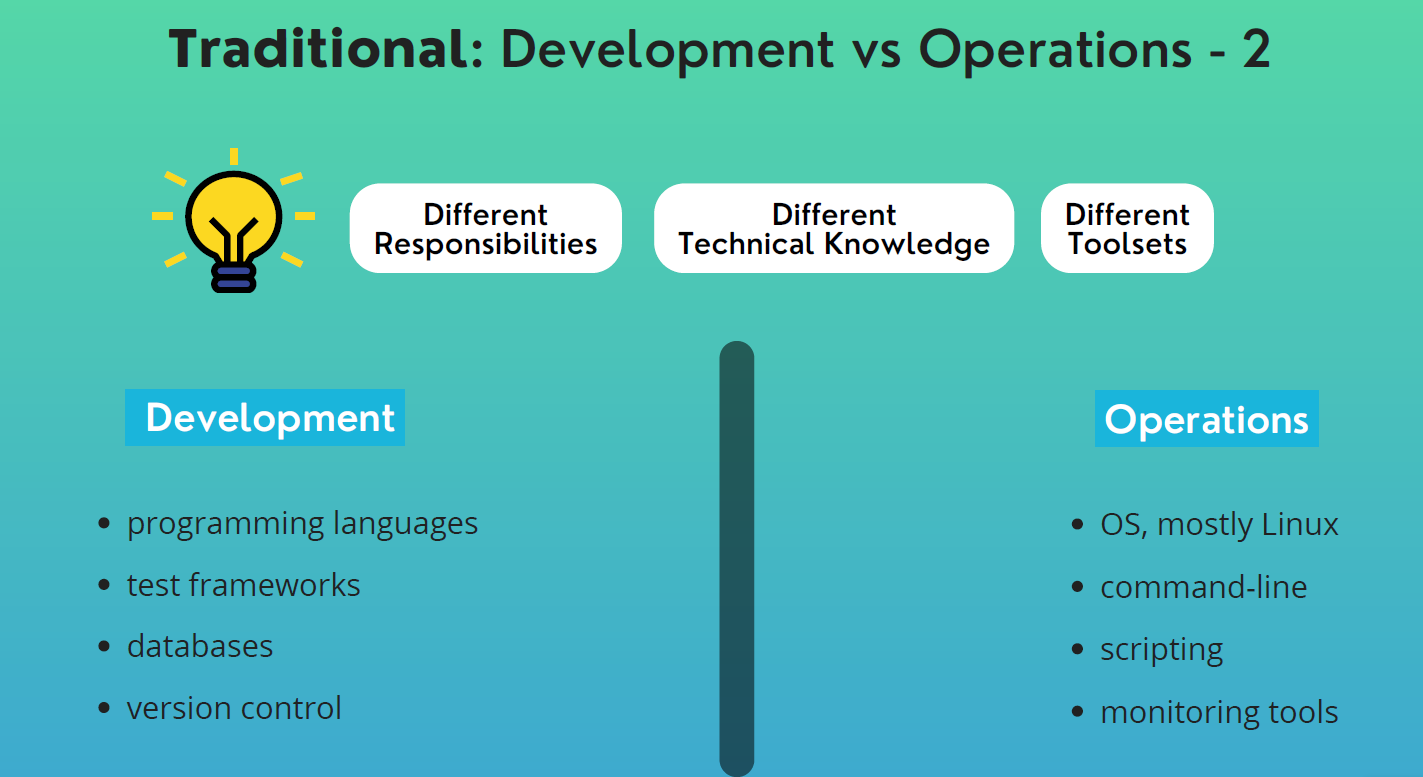
The image further explores the traditional division between development and operations, highlighting their distinct responsibilities, technical knowledge, and toolsets. Here’s a detailed explanation:
Traditional: Development vs Operations - 2
Key Differences:
Different Responsibilities:
Development: Focused on creating and enhancing the software by writing code, implementing new features, fixing bugs, and ensuring the software meets user requirements.
Operations: Responsible for deploying, managing, and maintaining the software in production environments. This includes ensuring system stability, monitoring performance, and handling incidents.
Different Technical Knowledge:
Development:
Proficient in various programming languages (e.g., Java, Python, JavaScript).
Familiar with test frameworks to ensure code quality.
Knowledgeable in databases for data storage and retrieval.
Skilled in version control systems (e.g., Git) for managing code changes.
Operations:
Expertise in operating systems, primarily Linux.
Proficient in using command-line interfaces to manage systems.
Skilled in scripting languages (e.g., Bash, PowerShell) for automation.
Knowledgeable in monitoring tools to track system performance and detect issues.
Different Toolsets:
Development:
Programming Languages: Tools and environments for writing and testing code.
Test Frameworks: Tools for unit testing, integration testing, and automated testing.
Databases: Systems for managing and querying data (e.g., MySQL, PostgreSQL).
Version Control: Systems for tracking changes in the codebase (e.g., Git, SVN).
Operations:
Operating Systems: Managing servers and environments, often with a focus on Linux distributions.
Command-Line Interfaces: Tools for managing and configuring systems.
Scripting: Automating repetitive tasks and system configurations.
Monitoring Tools: Systems for tracking application and server performance (e.g., Nagios, Prometheus).
Challenges in the Traditional Model
Communication Gaps:
- Separate responsibilities and toolsets can lead to communication breakdowns between development and operations teams.
Integration Issues:
- Code developed by the development team might not work as expected in the production environment managed by the operations team, leading to integration problems.
Deployment Delays:
- Manual handoffs between development and operations can introduce delays and errors in the deployment process.
Conflicting Goals:
- Development aims for rapid feature releases, while operations focuses on stability and reliability, leading to conflicting objectives.
Moving Towards DevOps
To overcome these challenges, many organizations are adopting a DevOps approach, which promotes:
Collaboration: Breaking down silos between development and operations through improved communication and shared responsibilities.
Automation: Implementing automated tools for testing, deployment, and monitoring to streamline the software delivery process.
Continuous Integration and Continuous Deployment (CI/CD): Integrating changes continuously and deploying them frequently to reduce the gap between development and production.
Shared Knowledge: Cross-training team members in both development and operations skills to foster a more versatile and collaborative workforce.
This integrated approach helps align the goals of rapid development and stable operations, leading to more efficient and reliable software delivery.
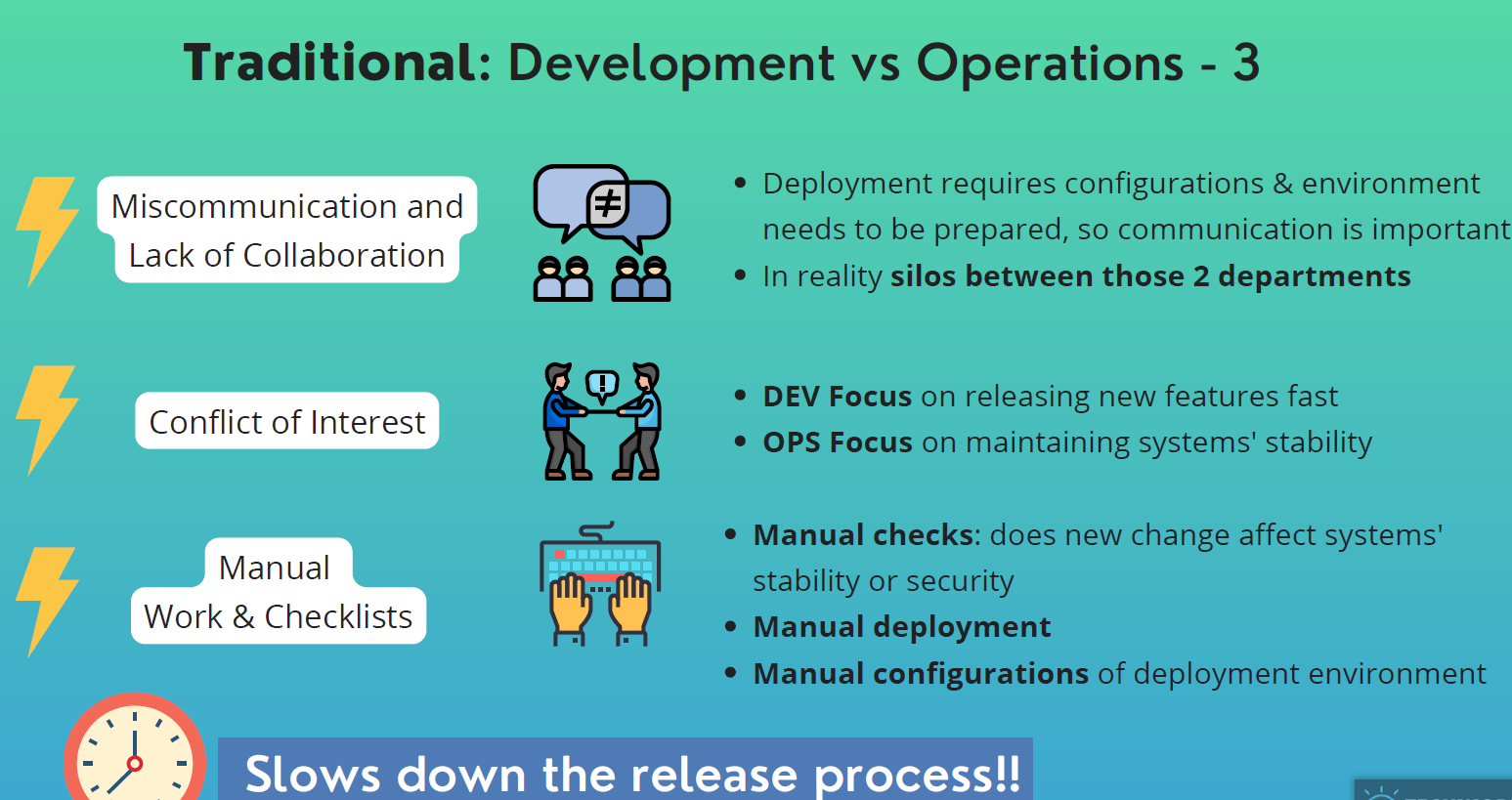
This image discusses the challenges of traditional development and operations (DevOps). The main issues are miscommunication and lack of collaboration between the two teams, leading to conflict of interest and manual work. This results in a slow release process.
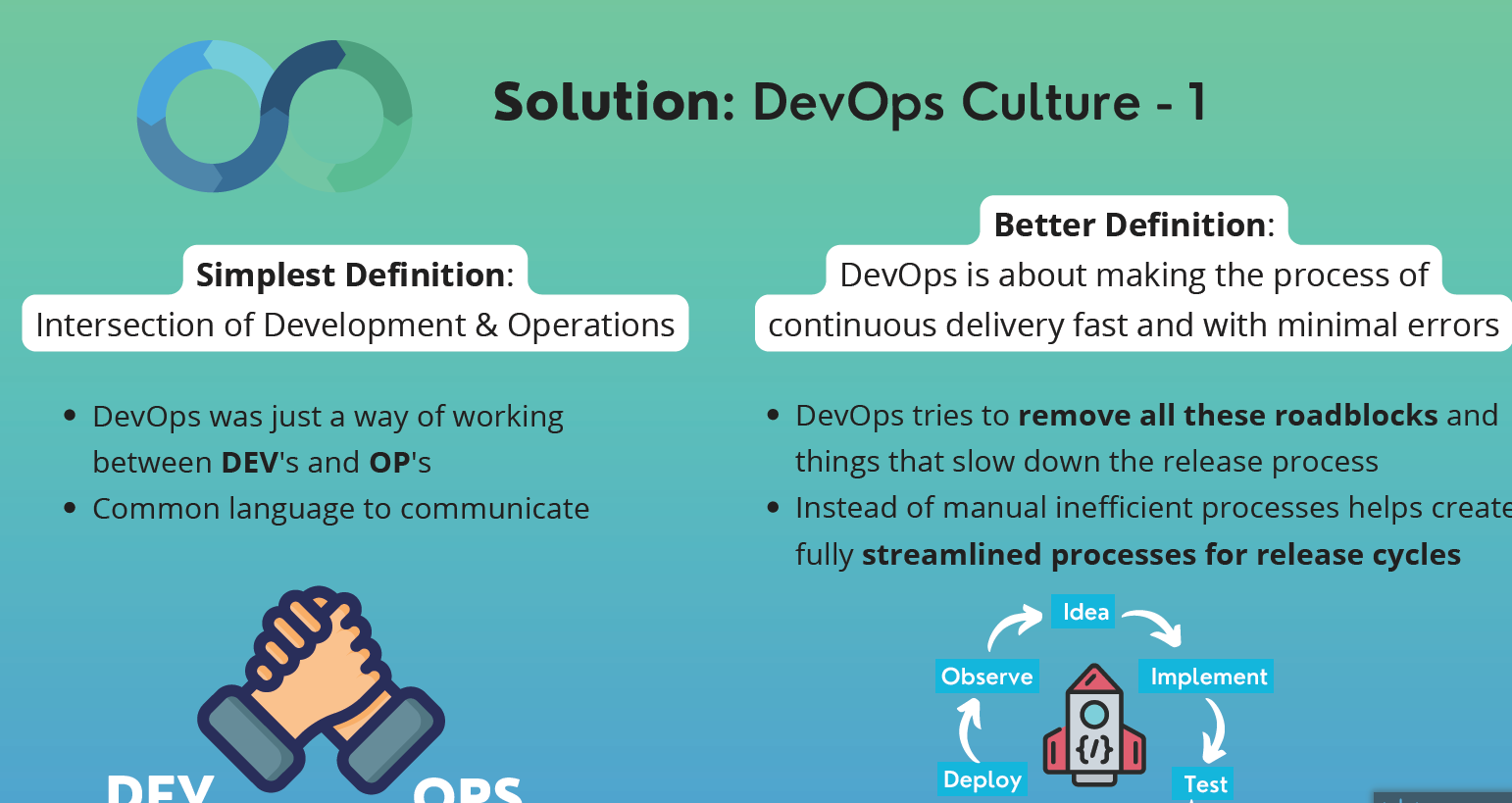
This image discusses the challenges of traditional development and operations (DevOps). The main issues are miscommunication and lack of collaboration between the two teams, leading to conflict of interest and manual work. This results in a slow release process.
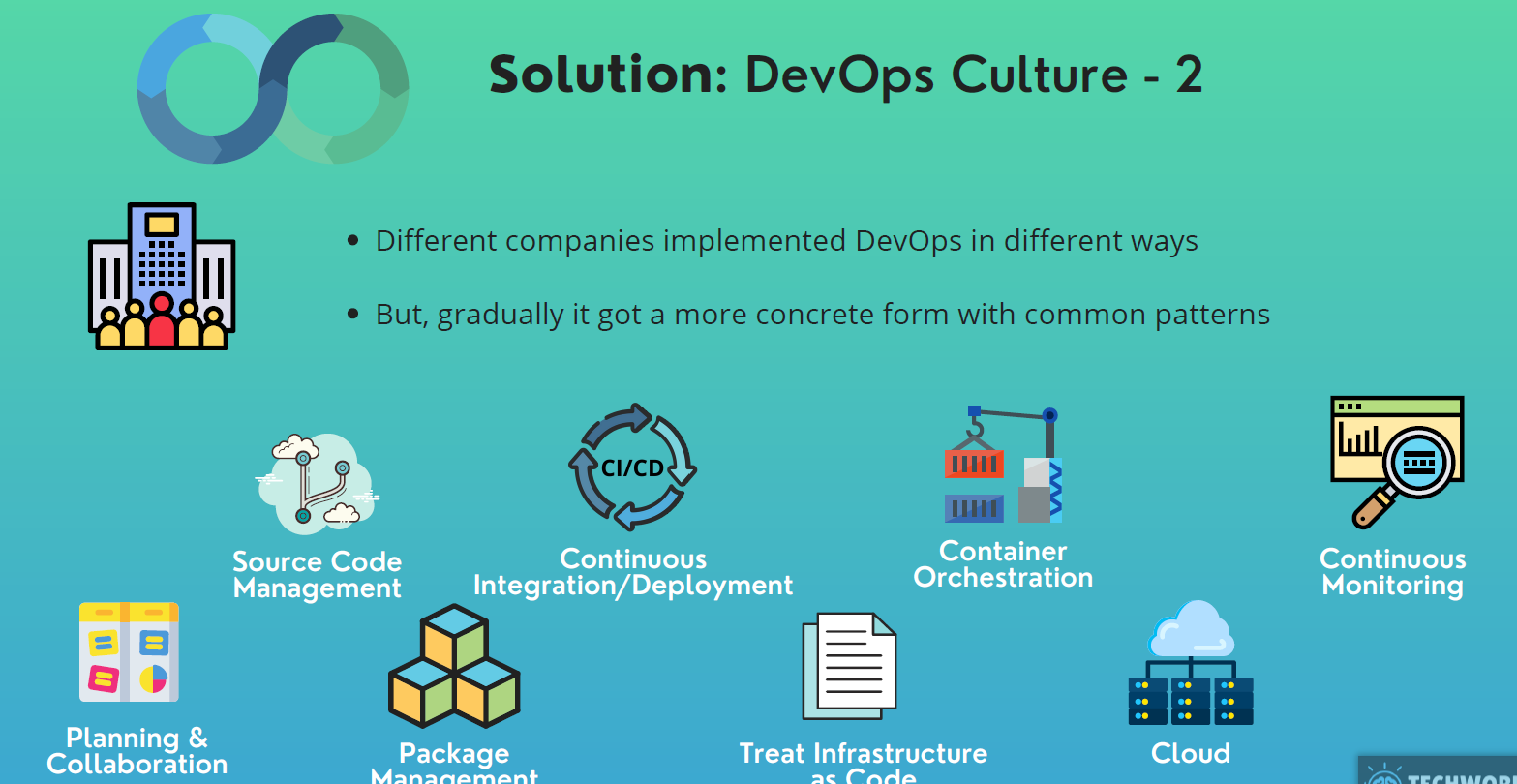
This image discusses the evolution of DevOps. It starts by mentioning that different companies have implemented DevOps in different ways. However, over time, common patterns have emerged, leading to a more concrete form of DevOps.
The image then highlights the key components of DevOps:
Continuous Integration/Continuous Delivery (CI/CD): This involves automating the building, testing, and deployment of code.
Container Orchestration: This refers to managing and deploying containerized applications.
Continuous Monitoring: This involves monitoring the performance and health of applications.
Source Code Management: This involves managing and versioning code.
Package Management: This involves managing and distributing software packages.
Infrastructure as Code: This involves managing and provisioning infrastructure using code.
Cloud: This refers to using cloud computing resources.
Planning & Collaboration: This involves planning and collaborating with other teams.
The image concludes by emphasizing the importance of DevOps culture in achieving successful DevOps implementation.
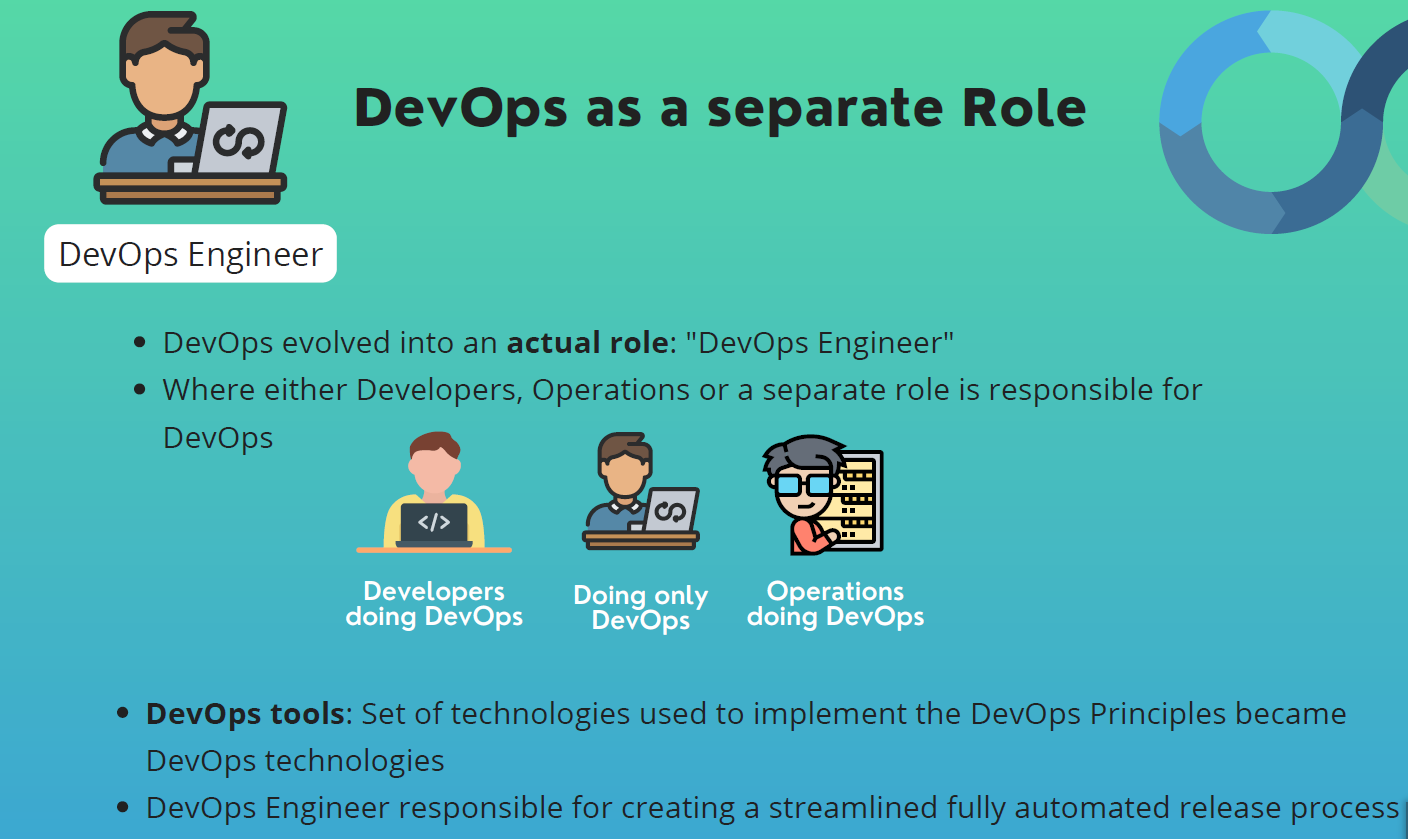
The image discusses the evolution of DevOps into a separate role, the DevOps Engineer.
Key points:
DevOps as a separate role: DevOps has evolved from being a shared responsibility between developers and operations to a dedicated role, the DevOps Engineer.
Responsibilities: DevOps Engineers are responsible for creating a streamlined and fully automated release process using DevOps tools and technologies.
DevOps tools: These are technologies that implement DevOps principles.
Before DevOps Engineer role:
Developers were solely responsible for DevOps.
Operations were solely responsible for DevOps.
Both developers and operations shared DevOps responsibilities.
Benefits of DevOps Engineer:
Increased efficiency and collaboration between development and operations teams.
Faster and more reliable software delivery.
Improved software quality.
Overall, the image highlights the growing importance of DevOps Engineers in modern software development.
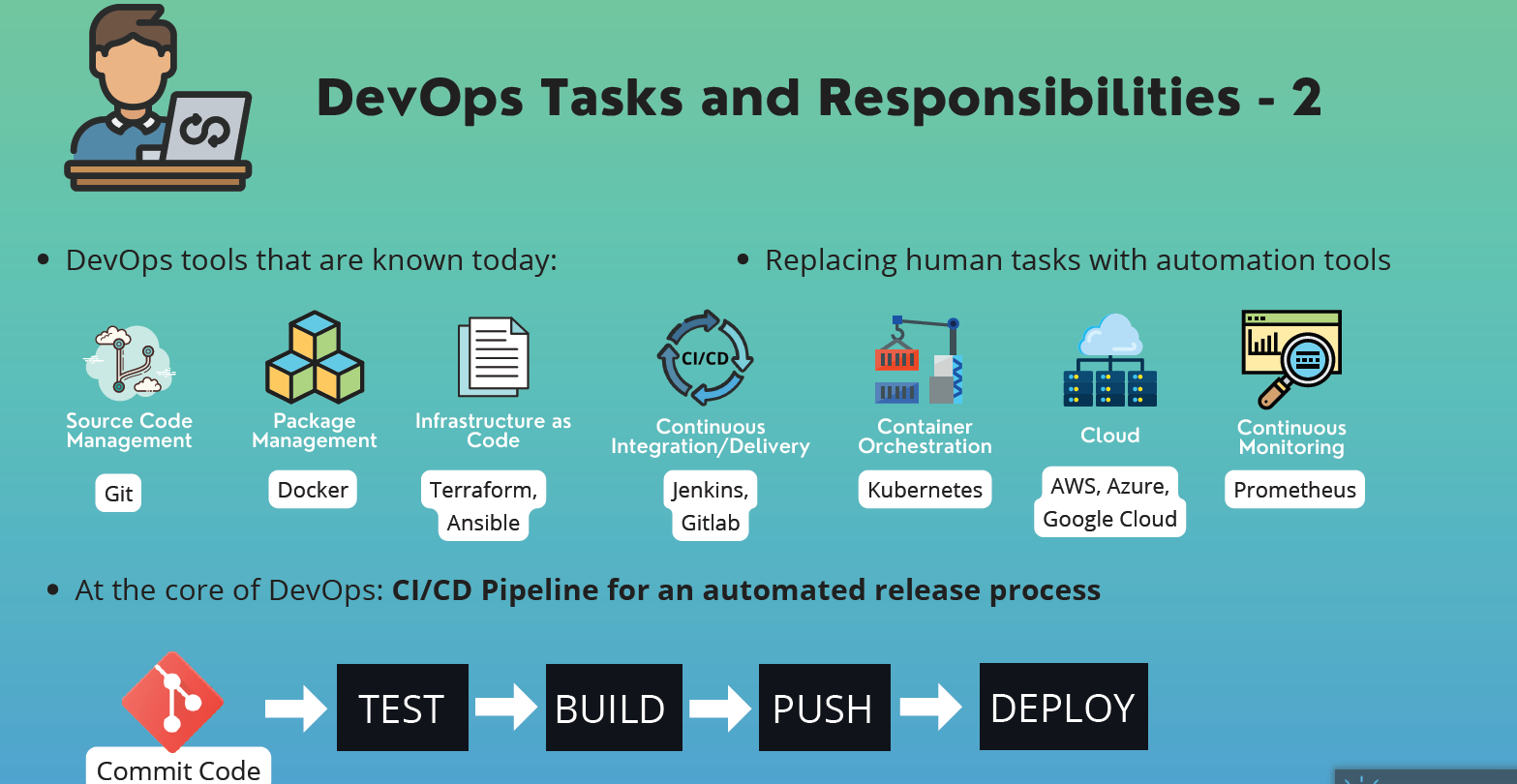
This image provides an overview of DevOps tasks and responsibilities.
DevOps Tools
Source Code Management: Git
Package Management: Docker
Infrastructure as Code: Terraform, Ansible
Continuous Integration/Delivery: Jenkins, Gitlab, CI/CD
Container Orchestration: Kubernetes
Cloud: AWS, Azure, Google Cloud
Continuous Monitoring: Prometheus
Core of DevOps: CI/CD Pipeline
The CI/CD pipeline is a key component of DevOps, automating the software release process. It consists of the following stages:
Commit Code: Developers commit code changes to the code repository.
Test: Automated tests are run to ensure code quality.
Build: The code is built into a deployable artifact.
Push: The artifact is pushed to a repository or registry.
Deploy: The artifact is deployed to the production environment.
Replacing Human Tasks with Automation Tools
DevOps aims to replace manual tasks with automation tools, improving efficiency and reducing errors. This includes automating tasks like code deployment, infrastructure provisioning, and testing.
Overall, the image highlights the importance of DevOps tools and the CI/CD pipeline in achieving efficient and automated software delivery.
Subscribe to my newsletter
Read articles from Ranjan Yadav directly inside your inbox. Subscribe to the newsletter, and don't miss out.
Written by
